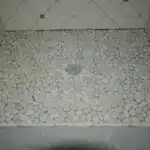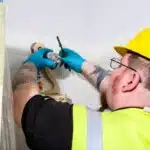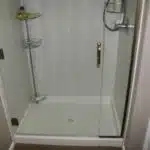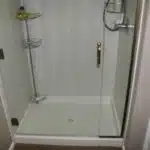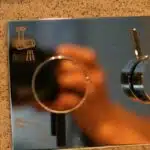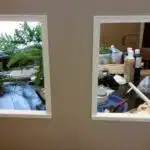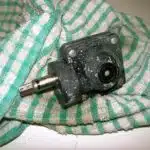Waterproofing a window in a shower is an essential task for homeowners who want to prevent water damage and ensure the longevity of their home. Poorly sealed windows can lead to mold growth, wood rot, and even structural damage. Therefore, it is crucial to take the necessary steps to waterproof your window properly.
In this article, we will guide you through the best practices for waterproofing a window in a shower. From selecting the right materials to sealing the gaps around the window frame, we will provide you with all the information you need to protect your home from water damage. Whether you are a DIY enthusiast or a professional contractor, this guide will help you achieve a successful and long-lasting waterproofing solution.
Assessing The Condition Of Your Window
As a home improvement contractor, assessing the condition of a window is crucial when it comes to waterproofing a shower. Before you start the project, take note of the quality of your window. Ensure that it is in good shape and free from any cracks or damage. A deteriorating window may lead to potential risks of water damage, which can cause long-term problems such as mold growth and structural damage.
Identifying potential leaks and vulnerabilities requires an evaluation of the window’s framing and sealing. The first step is to examine the caulking around the frame. If there are any gaps or cracks, these will need to be filled with silicone caulk to prevent water from seeping through. Check for any signs of wear and tear on the exterior trim as well.
Another area to focus on is the quality of the glass itself. Double-pane windows or tempered glass are more durable than single-pane windows and less prone to cracking. Additionally, make sure that any hardware surrounding the window, such as locks or hinges, are functioning correctly and have not rusted over time. By conducting an initial assessment of your shower window’s condition, you can prevent future water damage issues and ensure longevity for your shower space.
Identifying Potential Leaks And Vulnerabilities
Proper waterproofing of windows in a shower is crucial to prevent water damage, which can lead to costly repairs. Common causes of leaks include poorly installed or damaged window frames, gaps between the frame and wall, and missing or damaged caulking. Prevention tips include regular inspection of your shower window for any signs of wear and tear, proper installation by a professional contractor, and using high-quality waterproofing materials.
Signs of water damage can vary from discoloration on walls or ceilings to mold growth. If left untreated, water damage can compromise the structural integrity of your home and cause health problems. Repair options include fixing any leaks, replacing damaged materials, and installing new waterproofing systems. It’s important to address water damage as soon as possible to prevent further damage and potential health risks.
In order to properly repair any water damage caused by leaks around your shower window, it’s important to prepare the surface before installing new waterproofing materials. This involves removing old caulking and cleaning the area thoroughly. In the next section, we will discuss how to prepare the window surface for waterproofing in more detail.
Preparing The Window Surface
Identifying potential leaks and vulnerabilities is crucial for ensuring that your shower remains dry and free from water damage. Once you have identified any potential issues, you can begin preparing the window surface for waterproofing.
Window surface preparation is an essential step in the waterproofing process. It involves removing any existing caulking or sealant, cleaning the window frame thoroughly, and making sure that there are no cracks or gaps. This step is crucial because any imperfections in the window surface can compromise the integrity of your waterproofing.
Once you have prepared the window surface, it’s time to choose the right waterproofing materials. There are many options available, including liquid membranes, sheet membranes, and cementitious coatings. Each type of material has its own advantages and disadvantages, so it’s important to choose one that meets your specific needs.
- Protect your investment by choosing high-quality materials
- Ensure proper ventilation during installation
- Don’t rush through the preparation process – take your time to get it right
- Consider hiring a professional if you’re not comfortable with DIY waterproofing
- Regularly inspect your shower for signs of water damage
Choosing the right caulk and sealant is critical for achieving a long-lasting, watertight seal around your shower window. In the next section, we will discuss how to select the best caulk and sealant for your specific needs. By following these steps carefully, you can ensure that your shower remains leak-free and protected from water damage for years to come.
Choosing The Right Caulk And Sealant
- There are various types of caulk and sealant available on the market, each of which have different properties and applications.
- Comprehensively preparing the area to be sealed is essential, as the sealant needs to be applied to a clean, dry surface free of any debris.
- Following the manufacturer’s instructions is essential when making use of any caulk or sealant, as incorrect application can lead to substandard performance.
- Once the sealant has been applied, it is important to ensure that it is cured properly in order to provide the maximum level of waterproofing.
- Regular maintenance of the sealant is also important, as it may become loose or cracked over time, thus requiring repair or replacement.
- When waterproofing a window in a shower, the use of a specialized caulk or sealant designed for the purpose is recommended.
Types Of Caulk And Sealant
As a professional home improvement contractor, I understand the importance of choosing the right type of caulk and sealant for waterproofing a window in a shower. There are several types of caulk and sealant options available, each with its own unique properties and benefits.
One popular option is silicone caulk, which is known for its durability and flexibility. It can be applied using various techniques, such as using a caulking gun or your fingers. However, it’s important to note that silicone caulk does not adhere well to surfaces that have been previously painted or treated with other types of sealants.
Another option is polyurethane sealant, which is ideal for areas that experience high levels of moisture and water exposure. It adheres well to most surfaces and can withstand extreme temperatures. Applying this type of sealant requires following best practices such as cleaning the surface thoroughly before application and allowing sufficient time for it to dry completely.
Lastly, there’s acrylic caulk which is easy to apply and dries quickly but has less durability than silicone or polyurethane sealants. Best practices when applying acrylic caulk include using backer rods in deep cracks or gaps to ensure the proper amount of coverage. Overall, choosing the right type of caulk and sealant for waterproofing a window in a shower depends on factors such as moisture exposure levels, surface compatibility, and desired durability.
Preparation And Application
When it comes to waterproofing a window in a shower, choosing the right caulk and sealant is just the first step. Proper preparation and application are equally important for ensuring a successful outcome. Common mistakes during preparation can include failing to clean the surface thoroughly or not allowing sufficient drying time before applying the caulk or sealant. These mistakes can lead to poor adhesion, resulting in leaks and water damage.
Cost considerations are also important when selecting a caulk or sealant product. While some options may be more expensive upfront, they may offer greater durability and longevity in the long run, ultimately saving homeowners money on repairs and replacements down the road. It’s essential to balance cost with performance needs to find the best solution for each unique situation.
During application, attention to detail is key to achieving a professional finish. This includes using proper tools such as caulking guns, smoothing tools or your fingers, depending on the product used. Additionally, using backer rods in deep cracks or gaps with acrylic caulk can ensure proper coverage and prevent cracking over time. By following these best practices for preparation and application, homeowners can achieve effective waterproofing solutions that will stand up to years of use.
Curing And Maintenance
After choosing the right caulk and sealant, curing and maintenance are crucial steps in ensuring the effectiveness of waterproofing solutions. Curing refers to the process of allowing the caulk or sealant to dry completely before exposing it to water. This is necessary for preventing damage and ensuring a longer lifespan for the product. It’s important to follow the manufacturer’s recommended curing time, which can vary depending on factors such as humidity and temperature.
Tips for effective maintenance include regularly inspecting the caulk or sealant for signs of wear or damage, such as cracking or peeling. Any issues should be addressed promptly to prevent water from seeping through and causing further damage. Additionally, cleaning the area around the window regularly with non-abrasive cleaners can help prolong the life of the caulk or sealant by preventing buildup that can lead to deterioration over time.
By taking these steps for curing and maintenance, homeowners can ensure that their chosen caulk or sealant continues to perform effectively for years to come. Preventing damage and prolonging lifespan not only saves money on repairs and replacements but also provides peace of mind knowing that their shower window is properly protected from water damage.
Applying The Caulk To The Window Frame
Now that you have prepared the window frame for waterproofing, it’s time to apply caulk evenly around the edges. This is an important step in ensuring that water doesn’t seep through and damage your bathroom walls. When applying caulk, make sure that you choose the right color that matches your bathroom tiles or wall paint.
To start, cut the tip of the caulk tube at a 45-degree angle using a utility knife. Position the tube at a 45-degree angle on one end of the window frame and squeeze gently to apply a steady bead of caulk. Use a caulking gun to ensure an even application along all edges. Apply enough pressure to fill any gaps between the window frame and shower surround.
Continue applying caulk along all edges until you reach where you started from. Be careful not to overfill or underfill any gaps as this can affect how effective your sealing will be. Once done, use your finger or a wet cloth to smooth out any bumps or unevenness in the caulk line. This will give your window frame a neat finish and ensure that water doesn’t penetrate into any gaps.
Choosing the right caulk color is also essential when waterproofing your shower window frame. You want to make sure that it blends well with your bathroom decor and doesn’t look out of place. Take time to select a color that matches your tiles or wall paint before starting with this step.
Next step: Sealing Around Glass Panes
Sealing Around The Glass Panes
Like a ship’s captain plugging holes in the hull during a storm, sealing around your shower window glass panes is critical for keeping water out of unwanted places. Proper sealing ensures that water cannot seep into the surrounding wall cavities, where it can cause mold and mildew buildup. That is why you need professional guidance to help you maintain your shower windows and keep them watertight.
Glass panel maintenance is essential if you want to prevent leaks and maintain the appearance of your shower glass. Regular cleaning will remove soap scum, body oils, and water stains that can cause deterioration over time. Use a squeegee or microfiber cloth to wipe down the glass after each shower to prevent hard water stains from forming. Also, avoid using abrasive cleaning agents that can scratch or damage the glass surface.
Cleaning shower windows isn’t just about improving aesthetics; it’s also vital for preventing leaks around the glass panes. Before sealing around your window’s edges, ensure they are free of debris and contaminants by wiping them down with a clean rag or paper towel. Remember to use rubbing alcohol or another suitable cleaner to remove any excess residue on the surface.
- Use silicone-based sealant for better adhesion
- Clean surfaces before applying sealant
- Apply sealant generously but not excessively
- Allow sufficient curing time before using the shower
Now that you know how important it is to maintain your shower windows’ glass panels and clean them properly let’s move on to securing the window trim without compromising its waterproofing capabilities.
Securing The Window Trim
After sealing around the glass panes, the next step is to secure the window trim. This involves removing the trim and inspecting it for signs of wear or damage. Trim removal can be tricky, so it’s best to use a pry bar or putty knife to gently lift the trim away from the wall. Once removed, inspect the area closely for any gaps or holes that could allow water to seep in.
If you encounter any gaps or holes, there are alternative solutions to consider. One option is to fill them with caulk, which can help keep water out and prevent mold from growing. Another option is to use foam backer rod, which is a flexible material that can be easily inserted into gaps and then sealed with caulk. Regardless of which solution you choose, be sure to let everything dry completely before moving on to the next step.
Now that the trim has been secured and any gaps filled, it’s time to add a waterproof membrane around the window frame. This will provide an additional layer of protection against moisture and ensure that your shower remains leak-free. There are many different types of waterproof membranes available, including liquid-applied coatings and sheet membranes. Choose one that suits your budget and preferences, then carefully follow the manufacturer’s instructions for installation. With a properly installed waterproof membrane in place, you can rest easy knowing that your shower window is fully protected against water damage.
Adding A Waterproof Membrane
When choosing a waterproof membrane for a window in a shower, it is important to consider the type of material, the thickness of the membrane, and the area of application. The membrane should be applied carefully, using an appropriate adhesive and allowing sufficient time for curing. The curing process should be monitored regularly to ensure that the membrane is properly adhered to the surface, and that it is completely dry before being put to use. It is important to follow the manufacturer’s instructions carefully when applying the membrane to ensure that it is properly and securely applied. After the membrane is installed, it should be examined for any possible imperfections that may lead to water penetration. Finally, the membrane should be tested for water-resistance prior to use in a shower.
Choosing The Membrane
When it comes to waterproofing windows in a shower, choosing the right membrane is crucial. Membrane durability and cost effectiveness are two important factors to consider when selecting a waterproofing solution. There are several types of membranes available in the market, each with its own advantages and disadvantages.
One option for waterproofing a window in a shower is using a liquid-applied membrane. These types of membranes are easy to apply and can be used on almost any surface. However, they may not be as durable as other options and may require reapplication after some time.
Another popular choice is using sheet membranes made of materials like PVC or rubber. These types of membranes offer high durability and can last for many years without requiring maintenance or replacement. While they may be more costly than liquid-applied options, their longevity makes them cost-effective in the long run.
In conclusion, selecting the right membrane is an important step in waterproofing a window in a shower. Choosing between liquid-applied or sheet membranes should depend on factors such as durability and cost-effectiveness. By carefully considering these factors, homeowners can ensure that their shower windows remain leak-free for years to come.
Applying The Membrane
When adding a waterproof membrane to a shower window, selecting the right type of membrane is just the first step. Proper application is also crucial to ensuring that the membrane functions as intended. There are various tools and techniques available for applying different types of membranes.
For liquid-applied membranes, a brush or roller can be used to apply the material evenly onto the surface. It’s important to follow manufacturer instructions regarding thickness and number of coats needed for optimal effectiveness. With sheet membranes, a utility knife or scissors may be necessary to cut them into the desired shape and size before application. Adhesive or sealant can then be used to attach them securely onto the surface.
Whichever type of membrane is chosen, it’s important to take proper care during application to avoid mistakes that could compromise its effectiveness over time. By using appropriate tools and following manufacturer instructions carefully, homeowners can ensure that their shower windows remain leak-free for years to come.
Curing The Membrane
Adding a waterproof membrane to shower windows is an essential step in preventing leaks and water damage. After selecting the right type of membrane and applying it correctly, the curing process is just as important for ensuring optimal performance. Membrane curing refers to the period during which the material sets and hardens, forming a durable barrier against moisture.
The timeframe for membrane curing varies depending on the type of product used, as well as factors such as temperature and humidity levels. While some membranes may cure within a few hours, others may take several days or even weeks. It’s important to follow manufacturer instructions regarding specific curing times and best practices for optimal results. Tips for effective membrane curing include maintaining stable environmental conditions, avoiding premature traffic or use of the area, and periodically checking for any signs of damage or deterioration.
While traditional methods such as cement board installation can provide some level of waterproofing, using a dedicated waterproof membrane offers several advantages. These products are specifically designed to withstand exposure to moisture and provide a reliable barrier against leaks. Additionally, they can be more flexible than traditional materials, allowing them to conform to irregular surfaces without cracking or breaking. Overall, when combined with proper application techniques and thorough membrane curing, adding a waterproof membrane is an effective way to protect shower windows from water damage and ensure long-lasting performance.
Installing A Window Sill Pan
According to a recent survey, over 70% of homeowners prefer having natural light in their shower areas. One way to achieve this is by installing a window sill pan. The window sill pan acts as a barrier against water and moisture that can cause damage to the window frame and surrounding areas.
When choosing window sill materials, it is essential to consider durability and waterproofing capabilities. PVC, metal, and stone are popular options due to their resistance to water damage. The installation process involves cutting the sill pan material to size and fitting it onto the bottom of the window frame. This ensures that any water that enters the area drains out through the weep holes at the bottom.
Proper installation of a window sill pan is crucial in preventing water damage in your shower area. It provides an extra layer of protection against moisture that can lead to mold growth or wood rotting. Once installed, you can proceed with applying a waterproofing coating on both sides of the window frame for added protection.
Applying A Waterproofing Coating
Once the window area has been properly prepared, it’s crucial to apply a waterproofing coating that will protect it from water damage. There are several types of waterproofing coatings available on the market today, each with its own unique advantages and disadvantages. The most common type is a liquid membrane which is applied using a roller or spray gun. Other options include sheet membranes and cementitious coatings.
When applying a waterproofing coating, it’s important to follow the manufacturer’s instructions carefully. This may involve applying multiple layers of the coating and allowing each layer to dry completely before applying the next one. It’s also important to pay attention to any specific requirements for temperature and humidity levels during application.
While some homeowners may be tempted to try their hand at waterproofing themselves, there are many benefits to hiring a professional for this task. Professional contractors have experience working with different types of materials and can ensure that the job is done correctly from start to finish. They also have access to specialized equipment and tools that may not be available to homeowners who attempt this task on their own.
Moving on from here, testing for water tightness is an essential step in ensuring that your newly waterproofed window will keep water out of your shower area.
Testing For Water Tightness
How do you ensure that the waterproofing materials used on your shower window are effective? The answer is simple: test for water tightness. Even the most experienced home improvement contractors know the importance of testing for leaks before installing any fixture in a bathroom. Water can seep into small crevices and cause damage to insulation, drywall, and other parts of your home.
There are several leak detection techniques that you can use to test for water tightness. One popular method is using a water hose to simulate rainwater. First, seal off all openings around the window frame with waterproof tape or caulk. Then, turn on the water hose and direct it towards the window from different angles. Observe if there are any leaks or gaps where water can seep through.
Another technique is using smoke testers to detect air leaks around the window frame. This method involves generating smoke with a smoke machine and then blowing it into the bathroom through an open door or window. If there are any air leaks around the shower window, smoke will escape from these openings, indicating where repairs need to be made.
Now that you have tested your shower window’s waterproofing solution, it’s important to maintain it properly to avoid future leaks. In the next section, we’ll go over some tips for maintaining your waterproofing solution and ensuring its longevity.
Maintaining Your Waterproofing Solution
Once you have successfully waterproofed your shower window, it is important to maintain the integrity of the waterproofing solution. Proper maintenance will help prevent leaks and water damage in the future. Here are some prevention tips to remember when maintaining your waterproofing solution:
- Regularly inspect your shower for signs of wear and tear.
- Keep your shower clean and free from mold and mildew.
- Avoid using harsh chemicals that could damage the waterproofing material.
To ensure that your waterproofing solution remains effective, it is also recommended to use specific products that are designed for this purpose. Some product recommendations include:
- Silicone-based sealants
- Water-resistant grout
- Waterproofing membrane systems
By investing in these products, you can prolong the life of your waterproofing solution and avoid costly repairs down the road.
Remember, regular maintenance is key to preventing leaks and water damage in your shower. By following these prevention tips and using recommended products, you can rest assured that your shower window will remain fully functional for years to come.
Transition: While regular maintenance can help prevent issues with your waterproofing solution, sometimes problems may arise despite your best efforts. In the next section, we will explore some common issues that homeowners may encounter and provide troubleshooting solutions to keep their shower windows leak-free.
Troubleshooting Common Issues
When troubleshooting leaks around the frame of a window in a shower, it is important to inspect the window sealing and caulking to ensure a proper seal. If the caulking is cracked or missing, it should be replaced with waterproof caulk or silicone. Condensation buildup can cause mold and mildew growth, and it can be minimized by installing a window with a low-e coating. Proper window installation and ventilation are essential to guard against window leaks and condensation buildup.
Leaks Around Frame
When it comes to waterproofing a window in a shower, leaks around the frame are an all too common issue. This can be caused by a variety of factors, such as poor installation or aging caulking. If left unchecked, these leaks can lead to water damage and mold growth.
One of the most common mistakes homeowners make is using silicone caulk to seal gaps around the window frame. While silicone caulk may seem like a quick and easy fix, it is not a long-term solution. Over time, silicone caulk can deteriorate and allow water to seep through. A cost-effective solution is to use a high-quality polyurethane sealant instead. This type of sealant is more durable than silicone and will provide a better barrier against water intrusion.
Another cost-effective solution for leaks around the frame is to install flashing tape. Flashing tape is a self-adhesive tape that creates a watertight seal around the edges of the window frame. It is easy to install and can be applied directly on top of existing caulking or sealant. This type of tape is especially useful for windows with irregular shapes or sizes where traditional caulking methods may not be effective.
In conclusion, leaks around the frame are a common issue when waterproofing a window in a shower but there are cost-effective solutions available to address this problem. Homeowners should avoid using silicone caulk as their primary method of sealing gaps and consider using high-quality polyurethane sealants or flashing tape instead. By taking these steps, homeowners can prevent water damage and ensure their shower remains leak-free for years to come.
Condensation Buildup
Condensation buildup is another common issue that homeowners face when waterproofing a window in a shower. This occurs when warm, moist air from the shower comes into contact with the cooler surface of the window, causing water droplets to form on the glass. Over time, this moisture can lead to mold growth and damage to the window frame.
One effective way of preventing condensation is by reducing moisture buildup in shower windows. This can be achieved by ensuring proper ventilation in the bathroom. Installing an exhaust fan or opening a window during and after showers can help circulate air and reduce humidity levels. It is also important to wipe down the window after each use to remove any excess moisture.
Another solution for preventing condensation buildup is by installing double-paned windows. Double-paned windows are designed with two layers of glass separated by a sealed airspace. This helps prevent heat transfer and reduces the likelihood of condensation forming on the inside of the window. By taking these steps, homeowners can prevent unwanted moisture buildup and ensure their shower remains dry and free from damage over time.
Hiring A Professional Waterproofing Service
As a professional home improvement contractor, I highly recommend hiring a professional waterproofing service to secure your window in the shower. A well-installed waterproofing system provides numerous benefits, including protecting your house from water damage and reducing the risk of mold growth. Additionally, it can increase the value of your property and give you peace of mind knowing that your shower is safe and secure.
When it comes to costs, hiring a professional waterproofing service might seem expensive at first. However, considering the long-term benefits it provides, it’s a worthy investment for any homeowner. By hiring professionals, you can ensure that the job is done correctly the first time around, saving you money in potential repairs down the line. Moreover, most reputable waterproofing companies provide warranties on their workmanship and materials used, giving you added protection for years to come.
In summary, while there are many ways to waterproof a window in a shower on your own, hiring a professional waterproofing service offers several benefits that outweigh the costs. Protecting your property from water damage and mold growth is essential for maintaining its value and ensuring your family’s safety. With their expertise and experience in handling various types of waterproofing projects, professionals can guarantee high-quality workmanship that lasts for years to come. So why take unnecessary risks? Call your local waterproofing company today!
Moving forward into frequently asked questions about this topic: what are some common mistakes homeowners make when attempting to waterproof their showers?
Frequently Asked Questions
Hiring a professional waterproofing service can be an excellent option for those who are not confident in their DIY abilities or who want to ensure that the job is done correctly. A professional service will have the knowledge, experience, and tools necessary to waterproof your shower window properly. They will also be able to identify any potential problem areas and address them before they become bigger issues.
However, there are some pros and cons to consider when hiring a professional waterproofing service. The biggest advantage is that you can trust that the job will be done right the first time, which can save you time and money in the long run. On the other hand, hiring a professional can be more expensive than doing it yourself, so you’ll need to weigh the cost against the benefits.
When it comes to choosing products for waterproofing your shower window, there are many options available. Some of the best products include silicone caulk, polyurethane sealant, and waterproof membrane systems. Each product has its own benefits and drawbacks, so it’s essential to do your research and choose the one that works best for your needs. Keep in mind that using high-quality materials is crucial for ensuring that your shower window stays watertight over time.
Overall, whether you decide to hire a professional or do it yourself ultimately depends on your comfort level with home improvement projects and your budget. Just remember that proper waterproofing is essential for preventing water damage and maintaining a safe living environment in your home.
Conclusion
When it comes to waterproofing a window in your shower, there are several steps you can take to ensure that water doesn’t seep through and damage your home. First, assess the condition of your window and identify any potential leaks or vulnerabilities. Next, prepare the surface by cleaning it thoroughly and removing any old caulk or sealant.
Choosing the right caulk and sealant is crucial, as this will determine how well your window is protected from moisture. Apply the caulk carefully to the window frame, making sure to fill all gaps and cracks. Finally, maintain your waterproofing solution by inspecting it regularly and addressing any issues promptly.
According to a recent survey, over 50% of homeowners experience water damage in their homes at some point in their lives. This can be costly and time-consuming to repair, which is why taking preventative measures like waterproofing your shower window is crucial. By following these steps and investing in professional waterproofing services if needed, you can protect your home from water damage and ensure that it remains in good condition for years to come. As a professional home improvement contractor, I highly recommend taking these steps to keep your home safe and secure.
Image Credits
- “www.aadesignbuild.com, A&A Design Build Remodeling, Master Bathroom, Washington DC, Chevy Chase, Bethesda, Corner Shower and Tub, Corner Window, Lights, Aging in Place” by A&A Design Build Remodeling, Inc. (featured)












